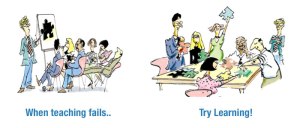Elearning is changing. Despite a decline in overall training expenditure since 2009 in the corporate sector, elearning itself has grown and is continuing to grow General budget constraints, reduction in training time and other mitigating factors appear to be the main drivers of the shift towards using e-learning. As the eLearning market continues to grow from strength to strength, it’s only natural that eLearning evolves too. Here are some key upcoming trends in this industry.
1.Big Data – Numbers in eLearning are becoming so large that processing user generated data using traditional methods is becoming impossible. Big data analysis can help eLearning in many ways – deeper understanding of learning process, helping track learner and group patterns, feedback analysis, compiling a comprehensive ROI report for learning.
- Gamification – This is arguably one of the most exciting developments. Gamification is the concept of applying game mechanics and game design techniques to engage and motivate people to achieve their goals. Learning based games can be quite easily implemented in many elearning courses and learning management systems. Almost 80% learners say that they would be more productive if their institution/ work was more game like.
- Personalized Learning – Personalized Learning is the tailoring of pedagogy, curriculum and learning environments to meet the needs and aspirations of individual learners. Some aspects of personalized learning are – adjusting the pace of instruction, adjusting the learning approach, allowing users to choose their own learning path, adjusting the form of content presentation between audio, video or text, leveraging participants experience and interests.
- Mobile Learning – As mobile use continues to grow, mobile will become the dominant medium for offering learning material. Devices like smartphones and tablets are allowing the learning to be on the move. In enterprises, the usage of tablets for business related activities and enterprise mobility is on the rise, making eLearning on tablets almost a necessity. Another related trend most commonly found in organizations in m-enablement – which is conversion of existing elearning courseware into tablet compatible format.
- Focus on ROI – Return on Investment (ROI) compares the investment in a training deliverable with the benefits over a specified period of time. Despite the traditional difficulties of calculating ROI, its importance will rise, as it provides a strong argument in favor of e-learning.
- APIs – Application Programming Interface (API) is basically the way applications communicate with each other. The widely accepted SCORM and Tin Can are two examples of APIs in eLearning. Systems like Zapier, offer non-programmable ways to integrate APls between services and achieve desired effects. TinCan API is the next generation of reporting for learning and LMSs around the world, if your LMS doesn’t support TinCan, then you are in for major problems! This year TinCan hit version 1.0, so expect to see even greater adoption the latter half of 2013.
- Automation – Content creation is a tedious and time consuming process. If we could somehow automate the process of content creation then we could potentially create a revolution in the quantity and quality of online courses. Areas where automation is possible are quizzes, tests, exercises generated automatically from course content, customizing content to each user by automatically matching difficulty levels to user skill levels.
- Augmented Learning – Augmented learning is an on-demand learning technique where the environment adapts to the learner. Augmented Reality market is expected to grow significantly – from 60 million users in 2013 to 200 million in 2018.
- Corporate MOOCs – Possibly the most controversial trend, MOOCs are causing quite the stir, but the utility of the model is not certain. Still, the possibility of MOOCs is quite exciting. Massive Open Online Courses are open courses for large numbers of users. MOOCs are often used by top universities. In the last few years MOOCs have also been getting more popular among companies and organizations in areas such as – internal training of big group of employees, open courses for teaching skills that are tailored to company’s future needs.
- Rise of Cloud LMS – Despite speculations about the death of LMS, last year showed continued growth in the industry. Forecasts for 2015 predict it will continue to grow. Out of all learning systems, cloud-based platforms had the highest growth in the last two years.


